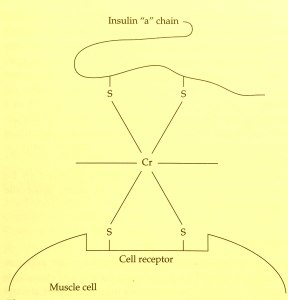Rats fed low chromium diets develop problems with their blood sugar including hyperglycaemia. Feeding such rats high chromium yeast reverses the metabolic dysfunction and returns blood sugar control to normal. Since the first discovery of chromium as an essential component of the rat diet, human studies have reported similar findings. Chromium is an essential component of the glucose tolerance factor (GTF) along with nicotinic acid and certain amino acids. The GTF is required for the correct disulfide bridging between the hormone insulin and its receptor on the surface of cells. Therefore the GTF is required for the potentiation of the action of insulin and thereby facilitates cellular glucose uptake. However, as well as a role in the structure of the GTF, evidence suggests that chromium may also facilitate the release of insulin from the pancreas, and allow the internalisation of insulin through increase membrane fluidity or regulation of insulin receptor production, expression and activity.

Figure 1. Diagrammatic representation of the possible role of the glucose tolerance factor in facilitating the binding of insulin to the insulin receptor.
The relationship between chromium and blood glucose control has been studied in humans. For example, in one study1, researchers used subjects with normal glucose tolerance to assess the relationship between chromium and blood sugar control. The results of the study showed that the fasting serum chromium levels were positively associated with the fasting serum insulin levels. In addition, the fasting serum chromium levels also positively associated with the percentage of ideal body weight and the skinfold thickness on the tricep (a measure of adiposity). The skin fold thickness on the tricep was also positively associated with the fasting insulin levels. Other studies have also found that serum chromium levels are higher in those who show higher fasting insulin levels. In addition, evidence from other studies shows that fasting chromium levels are higher in those who are fatter and therefore more likely to have glucose intolerance. Therefore absolute serum chromium levels might not be a good measure of chromium status.
When the authors calculated the relative chromium response, they found that the results looked more as would be predicted. The relative chromium response was calculated as the ratio of serum chromium 1 hour following insulin release to the fasting chromium levels. The relative chromium response of the subjects was inversely associated with total insulin and the total insulin to total glucose levels. This suggests that it is not the absolute chromium levels in the blood that are important, but the change in the levels following insulin release. Larger increases in chromium irrespective of the baseline levels are associated with better blood sugar control. When the authors split the subjects into high and low insulin secretion they found that the low secretors had significantly higher relative chromium responses compared to the high insulin secretion. Further, the ratio of total insulin to total glucose was significantly lower in the low insulin secretors compared to the high insulin secretory, suggesting better insulin sensitivity.
Dr Robert Barrington’s Nutritional Recommendation: Supplementation with brewers yeast or chromium supplements in cases of poor glucose tolerance lowers fasting blood sugar levels and improves insulin sensitivity. This suggests that poor chromium status is the cause of glucose intolerance, and not an effect. Chromium intakes are low in the West and it is likely that a large percentage of the population is marginal in their intake of chromium. This likely is one of the causes of the high incidence of insulin resistance and the high incidence of obesity in such countries. Eating a high quality diet containing unrefined sources of plant material along with chromium containing supplements are the way to ensure an adequate chromium intake and a functioning glucose system.
RdB
